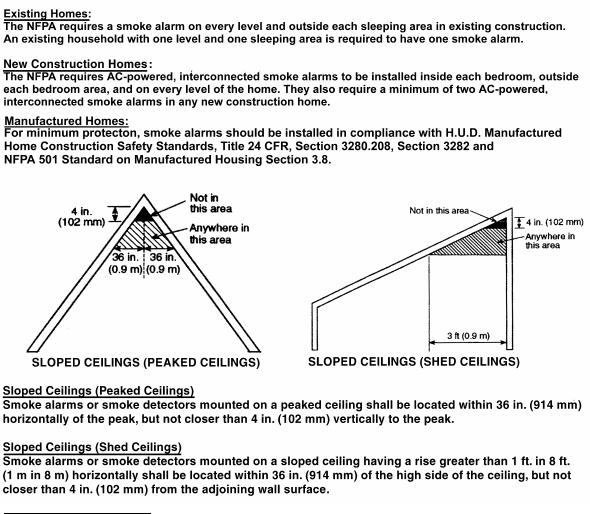
Mobile Home Installation:
For minimum protection, smoke alarms should be installed in compliance with H.U.D. Manufactured
Home Construction Safety Standards, Title 24 CFR, Section 3280.208 and Section 3282. For additional
protection, see Single Story Residence smoke alarm requirements/recommendations for Existing Homes
and New Construction Homes.
Note: For mobile homes built before 1978, install smoke alarms on inside walls between 4” and 12” from
the ceiling (older mobile homes have little or no insulation in the ceiling). This is especially important if
the ceiling is unusually hot or cold.
Install a smoke alarm inside each bedroom and in the hallway outside each separate sleeping area.
Page 5
AVOID THESE LOCATIONS
• the garage – products of combustion are present when you start your automobile.
• in areas with high humidity, like bathrooms or areas near dishwashers or washing machines.
Install at least 3 feet (0.9 meters) away from these areas.
• in areas of turbulent air such as air returns or heating and cooling supply vents. Install at least 3
feet (0.9 meters) away from these areas.
• in extremely dusty, dirty or insect-infested areas. Loose particles interfere with smoke alarm
operation.
• in areas where temperature may fall below 40
0
F (4.4
0
C) or rise above 100
0
F (37.8
0
C).
• closer than 5 feet (1.5m) from fluorescent lights, electrical "noise" and flickering may affect the
alarm's operation.
• do not locate this alarm within 5 feet (1.5m) of any cooking appliance.
• in areas of reverse venting of fuel burning appliances caused by outdoor ambient conditions,
such as:
- wind direction and/or velocity, including high gusts of wind. Heavy air in the vent pipes (cold/
humid air with extended periods between cycles).
- negative pressure differential resulting from the use of exhaust fans.
- simultaneous operation of several fuel burning appliances competing for limited internal air.
- vent pipe connections vibrating loose from clothes dryers, furnaces or water heaters.
- obstructions in or unconventional vent pipe designs which can amplify the above situations.
- extended operation of unvented fuel burning devices (range, oven, fireplace, etc.).
- temperature inversions which can trap exhaust gasses near the ground.
- car idling in an open or closed attached garage or near a home.











